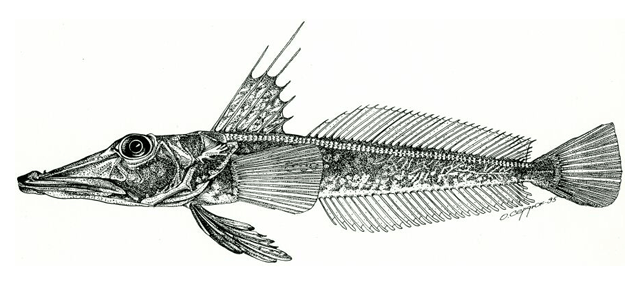| Channichthyidae (Crocodile icefishes) |
| 37.4 cm TL (female) |
|
demersal; marine; depth range 126 - 310 m |
| Southern Ocean, Sub-Antarctic: Kerguelen Islands. |
|
Dorsal spines (total): 7-8; Dorsal soft rays (total): 31-34; Anal spines: 0-0; Anal soft rays: 29-32. This species is characterized by the following D1 VII-VIII, D2 31-34; A 29-32; pectoral 19-20; bony tubular plates (scales) of the dorsal lateral line 61-78 and of the median lateral line 9-23, rounded separated bony plates in the anterior part of the median lateral line 4-28, as a rule, more than 10; number of gill-rakers on the outer side of the lower part of the 1st arch 6-15. This species is further distinguished by the following: interorbital width narrow, 1.0-1.4 times in horizontal orbit diameter, 5.8-7.5 in HL and 2.0-2.4 in head height at level of middle of eye; eye moderate in size, its diameter 5.2-6.3 times in HL and 2.6-3.0 in snout length; supraorbital outer bony edges of frontals noticeably elevated; snout relatively long, approximately equal to or somewhat shorter than half the head length, 2.1-2.2 in HL; tips of jaws aligned or lower jaw slightly protruding, teeth on symphysis not visible; posterior edge of maxillary extending below 1/3-1/2 of the orbit diameter; a row of rakers on lower part of first gill arch on the outer side of ceratobranchial; pectoral fin extending above to anus or origin of first anal fin ray; first dorsal fin high, 3.3-4.7 times in SL, second and third rays longest; fin membrane of D1 not reaching tips of longest rays, its height about 1.4-1.7 times in height of D1; dorsal fins well separated, posterior edge of D1 fin membrane not reaching first ray base of D2; interdorsal distance wide, 10.9-16.4 times in SL or 1.0-1.9 times in length of D1; bony tuberculation well developed on frontals and lacrimals, D1 flexible spines, branchiostegals, pelvic fins and on bony structures of both lateral lines; absent on maxillary and on anterior part of lower jaw (Ref. 90862). |
| Found on shelf waters of islands and caught in 2 bottom trawls at depths of 126 and 270-310 m, together with C. rhinoceratus, C. rugosus, C. panticapaei, C. bospori, C. irinae and C. mithridatis. Most specimens were caught at depth of 126 m in an area with abundant benthic fauna and the alga Macrocystis pyrifera. Apparently a primarily piscivorous predator (inferred from the single row of gill-rakers and similar to its congeners). Females mature at about 29-31 cm TL (25-27 cm SL); the post-spawning SGM VI-III is clearly detected in females larger than 31 cm TL and the SGM III - in the smaller, firstly maturing ones. The SGM of the males examined varied from stage II to early stage III in the specimen of 32.5 cm TL. Spawning and pre-spawning SGM were absent. Spawning period apparently takes a place from autumn to the beginning of winter (Ref. 90862). |
|
Not Evaluated (N.E.) Ref. (130435)
|
| harmless |
Source and more info: www.fishbase.org. For personal, classroom, and other internal use only. Not for publication.
